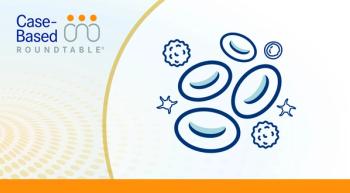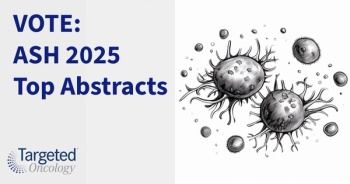
Study Results Show Chemoradiation Significantly Improves PFS in Follicular Lymphoma
According to findings from a multicenter randomized trial, chemoradiation for early-stage, low-grade follicular lymphoma led to significant improvement in progression-free survival (PFS) compared with involved-field radiotherapy alone (IFRT).
Michael MacManus, MD
According to findings from a multicenter randomized trial, chemoradiation for early-stage, low-grade follicular lymphoma led to significant improvement in progression-free survival (PFS) compared with involved-field radiotherapy alone (IFRT).
Patients who received chemotherapy in addition to IFRT had a 10-year PFS of 59% versus 41% for patients treated with radiotherapy alone. A trial protocol amendment allowing the addition of rituximab (Rituxan) to chemotherapy had a substantial impact on the PFS benefit, said Michael MacManus, MD, during the American Society for Radiation Oncology (ASTRO) meeting in Boston, Massachusetts.
The chemoradiation group had almost a double-digit improvement in overall survival (OS), but the difference compared with IFRT did not achieve statistical significance.
“Patients treated with systemic therapy had fewer transformations to high-grade lymphoma,” said MacManus, a radiation oncologist at Peter MacCallum Cancer Center in Melbourne, Australia. “PET-staged patients had superior progression-free survival. IFRT followed by 6 cycles of chemotherapy with rituximab would be a reasonable choice for the standard of care in stage I/II follicular lymphoma.”
Low-grade follicular lymphoma has a long, natural history, and IFRT has demonstrated potential to achieve a cure in stage I/II of the highly radiosensitive disease. Nonetheless, more than half of cases relapse following IFRT, primarily outside the radiation therapy treatment field, MacManus noted.
Whether the addition of chemotherapy to IFRT could reduce the frequency of relapse has remained unclear. A previous trial of radiotherapy plus chlorambucil yielded negative results. A small single-center phase II trial conducted more than a decade ago demonstrated encouraging 10-year freedom-from-treatment failure and OS in patients with stage I/II follicular lymphoma treated with radiation therapy plus COP-bleomycin or CHOP-bleomycin (J Clin Oncol.2003;21:2115-2122).
MacManus and colleagues conducted a randomized, phase III trial to determine whether combination chemotherapy administered after IFRT might improve PFS in patients with early-stage follicular lymphoma. The trial involved patients with stage I/II, grades 1/3a disease. PET staging was allowed but not mandated.
Investigators randomized patients to IFRT at a total dose of 30 Gy (administered in fractions of 1.5 to 2.0 Gy) or to the same IFRT protocol plus 6 cycles of CVP chemotherapy (subsequently amended to include rituximab, R-CVP). Patients with nodal involvement also received treatment of the involved nodal region with a craniocaudal margin of 5 centimeters, plus treatment of the adjacent uninvolved nodal region at the discretion of the patient’s radiation oncologist. Treatment of extranodal sites was individualized by site. Bulky sites received a 36-Gy radiation boost.
Patient accrual began in 2000. The protocol was amended in 2006 to mandate the addition of rituximab in the systemic therapy. The primary endpoint was PFS, and data analysis included 150 randomized patients, who had a median follow-up of 9.6 years.
The initial response assessment by computed tomography occurred after completion of IFRT. Patients were followed at 3-month intervals for 2 years, then every 6 months until 5 years, followed by annual assessments that included CT assessment of disease status.
Analysis of the primary endpoint yielded an 18-point absolute difference in favor of patients who received systemic therapy in addition to IFRT. The difference translated into a 43% reduction in the hazard for progression or death (P= 0.033).
“The survival curves did not begin to separate until after about 4 and a half years” said MacManus. “Had we performed a futility analysis at that point, we would have concluded that the study was negative. However, we continued the study despite slow accrual, and the results showed a significant benefit.”
To illustrate the impact of adding rituximab to systemic therapy, MacManus showed results of an analysis limited to those patients who received the anti-CD20 antibody. As compared with patients treated with IFRT alone from 2006 on, the patients who also received systemic therapy had a 74% lower hazard for disease progression or death (P= 0.045).
A similar proportion of patients in each arm underwent PET staging. MacManus said PET staging was associated with superior PFS.
Most patients in both arms had prolonged OS. Patients randomized to systemic therapy had numerically superior OS at 10 years (95% vs 86%). However, the difference did not achieve statistical significance (P= 0.40).
Systemic therapy also had a major impact on the occurrence of high-grade histologic transformation. More than twice as many patients treated with IFRT alone had disease transformation to high-grade lymphoma (10 vs 4 in the group that received IFRT plus systemic therapy).
Acute radiation toxicity occurred in almost all patients but was grade 1 severity in most cases. Chemotherapy was associated with additional toxicity, which was grade 1/2 in most cases. The most common grade 3/4 toxicity was infection, occurring in 7 patients. Late grade 3/4 toxicity consisted of 3 cases of neuropathy, menopausal symptoms in 1 patient, and pulmonary toxicity in 1 patient.
Reference:
MacManus M. Treatment with 6 cycles of CVP or R-CVP after involved field radiation therapy (IFRT) significantly improves progression-free survival compared to IFRT alone in stage I-II low grade follicular lymphoma: results of an international randomized trial. Presented at: 2016 ASTRO Annual Meeting; Boston, Massachusetts, September 25-28, 2016.









































